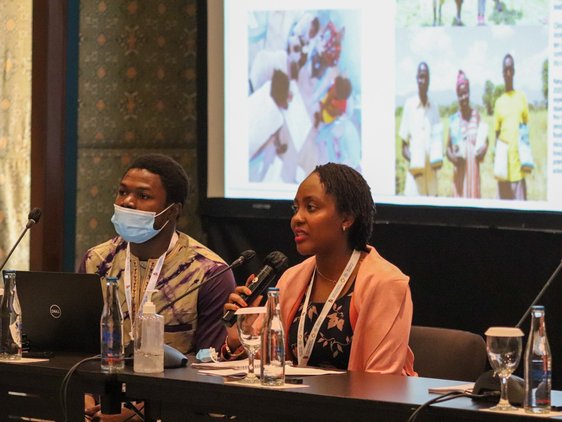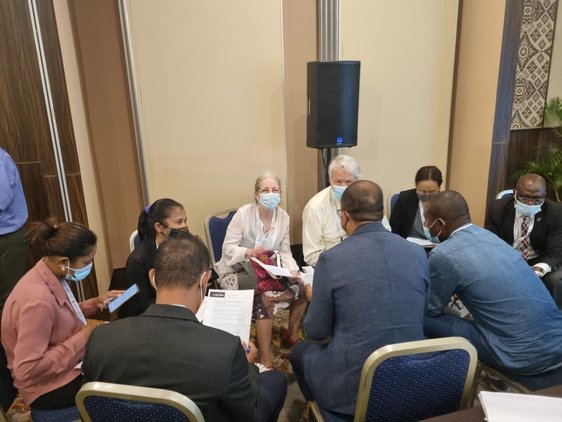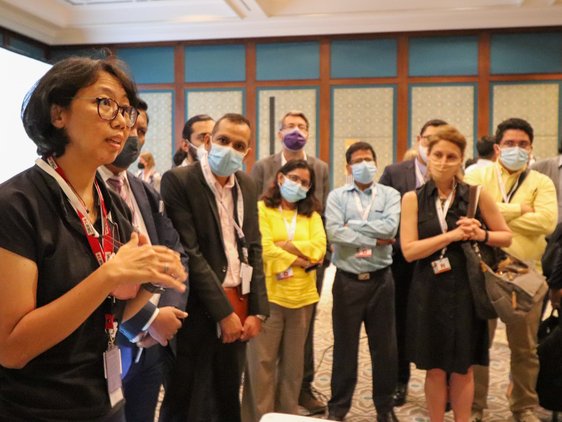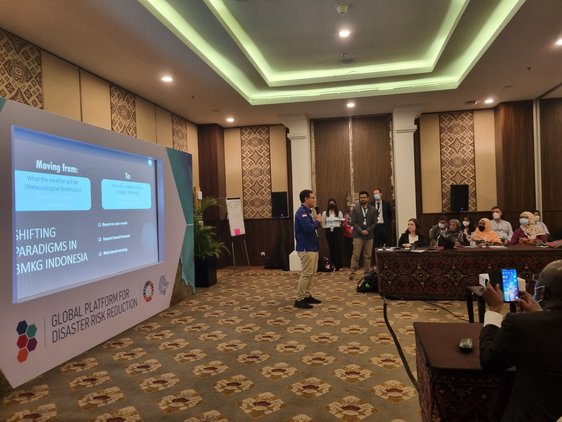Bridging Impact-based Forecasting and Anticipatory Action for Disaster Risk Reduction
The Global Platform on Disaster Risk Reduction and the Multi-hazard Early Warning Conference (23 - 27 May) enabled the disaster risk reduction (DRR) and hydro-meteorological communities to come together to discuss their journeys around impact-based forecasting (IBF) and anticipatory action (AA).
Two sessions co-organised by the Anticipation Hub and partners, including the UK Met Office, explored challenges and opportunities around IBF and AA and ambitions to sustainably scale up early warning early action efforts. The MHEWC-III learning session provided a platform to exchange experiences from Kenya, Burkina Faso, Nepal and Bangladesh through a World Cafe format. In comparison the GPDRR Learning Lab on IBF and AA focused on stimulating exchange between stakeholders by facilitating an interactive role-play exercise to develop an early action plan. The session then shared experiences on the challenges and opportunities on the IBF and AA journey in Indonesia.
Reflecting on the two sessions and the wider engagement at GPDRR and MHEWC-III, key messages emerged across four major areas, as explained in detail below.
You can read more about the wider engagement of the anticipatory action community at GPDRR here.

MHEWC-III impact-based forecasting and anticipatory action session (c) Anticipation Hub

Learning lab at GPDRR on impact-based forecasting and anticipatory action (c) UK Met Office

MHEWC-III impact-based forecasting and anticipatory action session (c) Anticipation Hub

BMKG speaking at the GPDRR Learning Lab on impact-based forecasting and anticipatory action (c) UK Met Office

MHEWC-III impact-based forecasting and anticipatory action session (c) Anticipation Hub
Learning lab at GPDRR on impact-based forecasting and anticipatory action (c) UK Met Office
MHEWC-III impact-based forecasting and anticipatory action session (c) Anticipation Hub
BMKG speaking at the GPDRR Learning Lab on impact-based forecasting and anticipatory action (c) UK Met Office
Key emerging messages
Capacity and understanding
Both impact-based forecasting (IBF) and anticipatory action (AA) are emerging topics in the early warning and early action value chain, thus we need to build capacity and understanding across the key stakeholders in the hydro-met and DRR communities. IBF has been primarily embraced by the hydro-met community, while anticipatory action is being championed by humanitarian and DRR practitioners. Impact-based forecasting methodologies, tools and procedures can directly feed the trigger-development process for early/ anticipatory action planning. Capacity building efforts should focus on what IBF and AA mean for DRR, what are the processes and methods, and most importantly the inter-linkages and opportunities to bridge IBF and AA.
Bringing a common understanding on how IBF services can inform the wider anticipatory action is crucial to ensure every early warning leads to early action that save lives, properties, and livelihoods. This can be done through continuous learning and knowledge exchange, sharing of experiences and training both nationally and internationally. A platform like the Anticipation Hub can play a key facilitation role in bridging this huge knowledge and capacity gap around IBF and AA across the stakeholders (see more here).
Multi-stakeholder collaboration and user engagement
The hydro-met and anticipatory action communities need to come together to co-produce IBF services including joint trigger development and co-design AA and IBF programmes and processes. Governments can play a key role in facilitating such multi-stakeholder collaboration at national level, for example through task forces or technical working groups. At risk communities are the key stakeholder for IBF and AA as the benefits are born by them. Therefore, engagement should happen at the community level, right from the start and throughout the entire process of IBF and AA, so that whatever climate and weather information are being produced are understandable and actionable. Anticipatory interventions need to be effective and appropriate to reduce or prevent disaster impacts for the given context/situation. This is all about finding a right balance between what is being demanded and what’s being offered or delivered to the at-risk communities. We need to bring community voices especially by engaging people with disabilities, children, youth, elderly, minorities and displaced people in the overall framing of IBF service and AA design/implementation, so that AA and IBF processes are inclusive and reach the last mile effectively.
Likezo Musobani from the Zambia Disaster Management and Mitigation Unit shares the impact of anticipatory action for the communities on the ground.
Watch our VideoPlay Video
Access and usability of data
Access to data is very challenging, especially in the developing context. When it comes to generating reliable forecasts, availability of vulnerability, and impact data is limited and if available lacks enough granularity and specificity. Data sharing and collaboration across national hydrometeorological services (NHMS), national disaster management authorities (NDMOs), humanitarian and DRR actors is essential to scale up IBF and AA activities. Also, important is the translation of such data and forecasts into useful and actionable information. NHMSs, NDMOs, humanitarian actors and communities need to work together to bridge this gap. Jointly, there is a need for a standardization of the process of risk data collection, analysis, quantification, and visualization including the integration of hazard forecast information so that the impact-based forecasts are fit for purpose for any anticipatory actions.
In an interview with Tshepho Ngobeni, senior forecasting manager, Southern African Weather Service he explains that -
“with impact-based forecasting we are infusing the vulnerability information so it is important to work with stakeholders including communities and NGOs to make sure that everybody understands the vulnerability so that they can take early action prior to the disaster”
Watch the full interview via the link below.
Watch our Video
Play Video
Government buy-in and ownership
In recent years, there has been huge momentum growing around anticipatory action across the humanitarian world with more and more organizations joining the efforts on anticipatory planning and investment. This is quite promising, however when it comes to scale, these efforts are still quite constrained. Therefore, it is important to bring national and local governments on board on an anticipatory agenda for a strong government buy-in and ownership. A clear narrative and understanding around how AA and IBF fits within the broader DRR and management efforts needs to be established, and more importantly the alignment between AA and the existing legislation, policies, frameworks and plans on DRR has to be carefully explored. More coordination and advocacy at national and regional level in particular setting legal policy and strategy and integrating AA into DRR frameworks is needed to move from piloting to scaled up action.
Call to continue the conversation!
The Anticipation Hub invites the hydro-met community to continue to exchange with humanitarian and DRR actors via the Anticipation Hub. Please get in touch if you would like to share resources or jointly organize learning activities.
You can find more resources on IBF and AA, including an introduction video, in the link below.
Access resources here
This blog was written by Madhab Uprety, Red Cross Red Crescent Climate Center and Lydia Cumiskey, Anticipation Hub. For more information please contact Madhab at uptrety@climatecentre.org.
